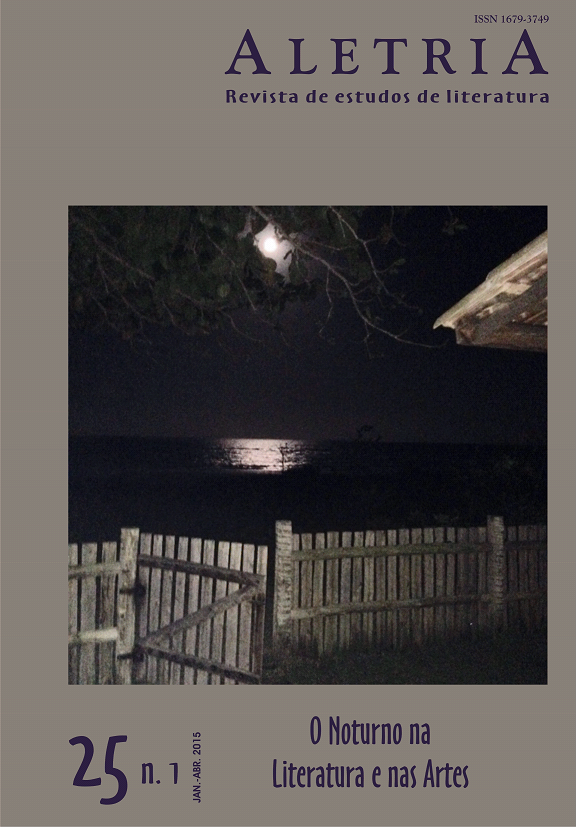The Nocturnal Time in “Cicatrices” by Juan José Saer
DOI:
https://doi.org/10.17851/2317-2096.25.1.113-128Keywords:
time, experience, perspective, game, representationAbstract
From the publication of Cicatrices (1969), Juan José Saer designs a new narrative perspective in which the essential is the meticulous work with the structure of the novel. This debate is consolidated by means of the detachment of perspective and the spread of a more objective relationship to the world. The priority in Cicatrices is time structures: the characters are struggling against temporal succession and casting aside their own experience. Time stuns senses making it impossible for the character to have a complete experience: it ends up that the way out is a different relationship with the world. The novel thus has four voices which differently rival the time diachrony: the first narrator resorts to representation; the second of this game, the third from the translation, and the last one discuss man’s freedom or the possibility of defeating destiny. These actions are gestured by means of a direct confrontation with time and thus enhance its place as the impairer of one’s own experience.
Downloads
References
ARCE, Rafael. El ciclo de novelas sobre el tiempo: Saer y Robbe-Grillet. In: LOGIE, Ilse (Coord.). Juan José Saer: La construcción de una obra. Sevilla: Universidad de Sevilla, 2013. p. 89-105. (Colección Escritores del cono sur 6).
BAKHTIN, Mikhail. Estética da criação verbal. Tradução de Maria Ermantina Galvão Gomes Pereira. São Paulo: Martins Fontes, 1992.
ISER, Wolfgang. O jogo do texto. In: LIMA, Luiz Costa (Coord. Trad.). A literatura e o leitor: textos de estética da recepção Hans Robert Jauss... et al. Rio de Janeiro: Paz e Terra, 2002. p. 105-118.
KANT, Immanuel. Crítica da faculdade do juízo. Tradução de Valerio Rohden e António Marques. Rio de Janeiro: Forense Universitária, 1993.
KANT, Immanuel. Estética transcendental. In: KANT, Immanuel. Crítica da razão pura. Tradução e notas de Fernando Costa Mattos. Petrópolis: Vozes; Bragança Paulista, SP: Editora Universitária São Francisco, 2012.
LOGIE, Ilse (Coord.). Juan José Saer: La construcción de una obra. Sevilla: Universidad de Sevilla, 2013. p. 11-37. (Colección Escritores del cono sur 6).
MERLEAU-PONTY, Maurice. O visível e o invisível. 3. ed. São Paulo: Editora Perspectiva, 1992.
MERLEAU-PONTY, Maurice. Fenomenologia da percepção. Tradução de Carlos Alberto Ribeiro de Moura. 2. ed. São Paulo: Martins Fontes, 1999.
SAER, Juan José. Nadie nada nunca. Buenos Aires: Seix Barral, 1995.
SAER, Juan José. El concepto de ficción. Buenos Aires: Espasa Calpe, 1997.
SAER, Juan José. La narración-objeto. Buenos Aires: Seix Barral, 1999.
SAER, Juan José. La mayor. Buenos Aires: Seix Barral, 2001.
SAER, Juan José. El limonero real. Buenos Aires: Seix Barral, 2002.
SAER, Juan José. Cicatrices. Buenos Aires: Seix Barral 2003.
SCAVINO, Dardo. Saer y los nombres. Buenos Aires: El Cielo por Asalto, 2004.
ZIELINSKI, Agata. La notion de «transcendance» dans Le visible et l’invisible: de l’indetermination au désir. In: SAINT AUBERT, Emmanuel de (Dir.). Maurice Merleau-Ponty. Hermann Éditeurs: Paris, 2008. p. 217-249. [Avec un texte inédit de Maurice Merleau-Ponty: La nature ou le monde du silence].
Downloads
Additional Files
Published
How to Cite
Issue
Section
License
Copyright (c) 2015 Raquel Alves Mota (Autor)

This work is licensed under a Creative Commons Attribution 4.0 International License.
Authors who publish with this journal agree to the following terms:Authors retain copyright and grant the journal right of first publication with the work simultaneously licensed under a Creative Commons Attribution Non-Commercial No Derivatives License that allows others to share the work with an acknowledgement of the work's authorship and initial publication in this journal.Authors are able to enter into separate, additional contractual arrangements for the non-exclusive distribution of the journal's published version of the work (e.g., post it to an institutional repository or publish it in a book), with an acknowledgement of its initial publication in this journal.Authors are permitted and encouraged to post their work online (e.g., in institutional repositories or on their website) prior to and during the submission process, as it can lead to productive exchanges, as well as earlier and greater citation of published work (See The Effect of Open Access).





